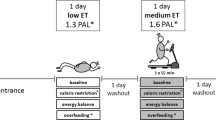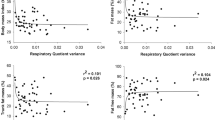Abstract
OBJECTIVE: This study compared fat oxidation rates during an acute bout of cycle ergometry exercise (E) typical of progressive fat oxidation in healthy, but sedentary, women of different obesity histories.
DESIGN: Five never‐obese (NO) (mean age=25±3 (s.e.)y, mean body fat=25.0±2.8 (s.e.)%), five obese (O) (26±3 y, 44.4±1.7%), and five post‐obese (PO) (22±1 y, 32.2±3.0%) women cycled for 60 min at 60–65% peak VO2. To identify the specific effects of E, a control trial consisting of 60 min of seated rest (R) was also performed. E and R trials were counterbalanced one month apart in the follicular phase and conducted following a 3 d normalized, eucaloric diet.
MEASUREMENTS: Dual energy X‐ray absorptiometry (DEXA) was used to determine body composition, and all were weight stable for at least eight weeks prior to experimentation. During both trials breath by breath measurements of VO2 and RER were used to determine substrate oxidation and energy expenditure. Blood samples were collected for hormone and metabolite analysis before, and every 15 min during exercise or rest.
RESULTS: All three groups showed a similar and progressive shift toward fat oxidation as exercise progressed. No group differences were observed for E energy expenditure or fat oxidation. Glycerol (P<0.0001) and free fatty acids (P<0.0001) increased similarly in all three groups, but PO maintained the highest free fatty acid level during exercise (group effect; P<0.01). E and R decreased (P<0.001 for both) insulin levels across groups, with lowest levels noted in PO and highest in O. Plasma epinephrine (P<0.0001) and norepinephrine (P<0.001) increased similarly during E in all three groups. Plasma growth hormone (GH) levels rose (P<0.05) during E, with a pronounced increase observed in PO.
CONCLUSION: We conclude that exercise of equal relative intensity elicited similar fat oxidation rates among NO, O, and PO women, despite group differences in free fatty acid availability. The PO women's persistently lower insulin and higher plasma GH levels may have enhanced free fatty acid availability.
This is a preview of subscription content, access via your institution
Access options
Subscribe to this journal
Receive 12 print issues and online access
$259.00 per year
only $21.58 per issue
Buy this article
- Purchase on Springer Link
- Instant access to full article PDF
Prices may be subject to local taxes which are calculated during checkout
Similar content being viewed by others
Author information
Authors and Affiliations
Corresponding author
Rights and permissions
About this article
Cite this article
Ezell, D., Geiselman, P., Anderson, A. et al. Substrate oxidation and availability during acute exercise in non‐obese, obese, and post‐obese sedentary females. Int J Obes 23, 1047–1056 (1999). https://doi.org/10.1038/sj.ijo.0801037
Received:
Revised:
Accepted:
Published:
Issue Date:
DOI: https://doi.org/10.1038/sj.ijo.0801037
Keywords
This article is cited by
-
Factors Influencing Substrate Oxidation During Submaximal Cycling: A Modelling Analysis
Sports Medicine (2022)
-
The Effect of a Single Bout of Continuous Aerobic Exercise on Glucose, Insulin and Glucagon Concentrations Compared to Resting Conditions in Healthy Adults: A Systematic Review, Meta-Analysis and Meta-Regression
Sports Medicine (2021)
-
Exercise as ‘precision medicine’ for insulin resistance and its progression to type 2 diabetes: a research review
BMC Sports Science, Medicine and Rehabilitation (2018)
-
The prediction of body composition in Chinese Australian females
International Journal of Obesity (2001)



